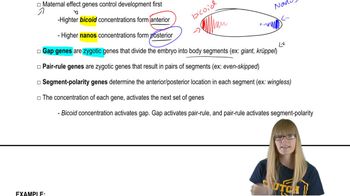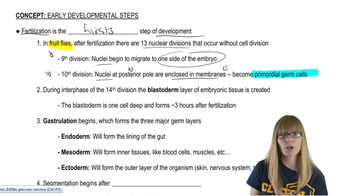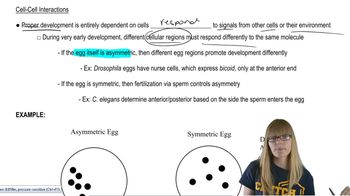Table of contents
- 1. Introduction to Genetics51m
- 2. Mendel's Laws of Inheritance3h 37m
- 3. Extensions to Mendelian Inheritance2h 41m
- 4. Genetic Mapping and Linkage2h 28m
- 5. Genetics of Bacteria and Viruses1h 21m
- 6. Chromosomal Variation1h 48m
- 7. DNA and Chromosome Structure56m
- 8. DNA Replication1h 10m
- 9. Mitosis and Meiosis1h 34m
- 10. Transcription1h 0m
- 11. Translation58m
- 12. Gene Regulation in Prokaryotes1h 19m
- 13. Gene Regulation in Eukaryotes44m
- 14. Genetic Control of Development44m
- 15. Genomes and Genomics1h 50m
- 16. Transposable Elements47m
- 17. Mutation, Repair, and Recombination1h 6m
- 18. Molecular Genetic Tools19m
- 19. Cancer Genetics29m
- 20. Quantitative Genetics1h 26m
- 21. Population Genetics50m
- 22. Evolutionary Genetics29m
14. Genetic Control of Development
Early Developmental Steps
Problem 10b
Textbook Question
Ablation of the anchor cell in wild-type C. elegans results in a vulva-less phenotype.
What phenotype is to be expected if the anchor cell is ablated in a let-23 loss-of-function mutant?
 Verified step by step guidance
Verified step by step guidance1
Understand the role of the anchor cell in C. elegans development. The anchor cell is crucial for inducing vulval development by signaling to the vulval precursor cells (VPCs).
Recognize that let-23 is a gene encoding a receptor tyrosine kinase involved in the signaling pathway for vulval induction. A loss-of-function mutation in let-23 disrupts this signaling.
Consider the phenotype of a let-23 loss-of-function mutant. Without functional LET-23, the VPCs do not receive the necessary signal to form a vulva, leading to a vulva-less phenotype.
Analyze the effect of ablating the anchor cell in a let-23 loss-of-function mutant. Since the mutant already exhibits a vulva-less phenotype due to disrupted signaling, removing the anchor cell, which is the source of the signal, would not change the phenotype.
Conclude that the expected phenotype when the anchor cell is ablated in a let-23 loss-of-function mutant is the same as the mutant alone, which is vulva-less.
Recommended similar problem, with video answer:
 Verified Solution
Verified SolutionThis video solution was recommended by our tutors as helpful for the problem above
Video duration:
2mPlay a video:
Was this helpful?
Key Concepts
Here are the essential concepts you must grasp in order to answer the question correctly.
Anchor Cell Function
In C. elegans, the anchor cell is crucial for vulval development as it signals to surrounding cells to form the vulva. This signaling is mediated through the induction of a specific cell fate in the vulval precursor cells. When the anchor cell is ablated, it disrupts this signaling pathway, leading to a vulva-less phenotype in wild-type organisms.
Recommended video:
Guided course

Functional Genomics
let-23 Gene and Its Role
The let-23 gene encodes a receptor tyrosine kinase that is essential for vulval induction in C. elegans. In wild-type organisms, let-23 is activated by signals from the anchor cell, promoting the development of vulval precursor cells. A loss-of-function mutation in let-23 impairs this signaling, preventing the proper formation of the vulva even in the presence of the anchor cell.
Recommended video:
Guided course

Segmentation Genes
Phenotypic Outcomes of Genetic Mutations
Phenotypic outcomes in genetics refer to the observable traits resulting from the interaction of an organism's genotype with its environment. In the case of the let-23 loss-of-function mutant, the expected phenotype upon ablation of the anchor cell would likely be a vulva-less phenotype, similar to the wild-type scenario, since the signaling pathway necessary for vulval development is already compromised.
Recommended video:
Guided course

Mutations and Phenotypes

 3:46m
3:46mWatch next
Master Drosophilia Development with a bite sized video explanation from Kylia Goodner
Start learningRelated Videos
Related Practice



